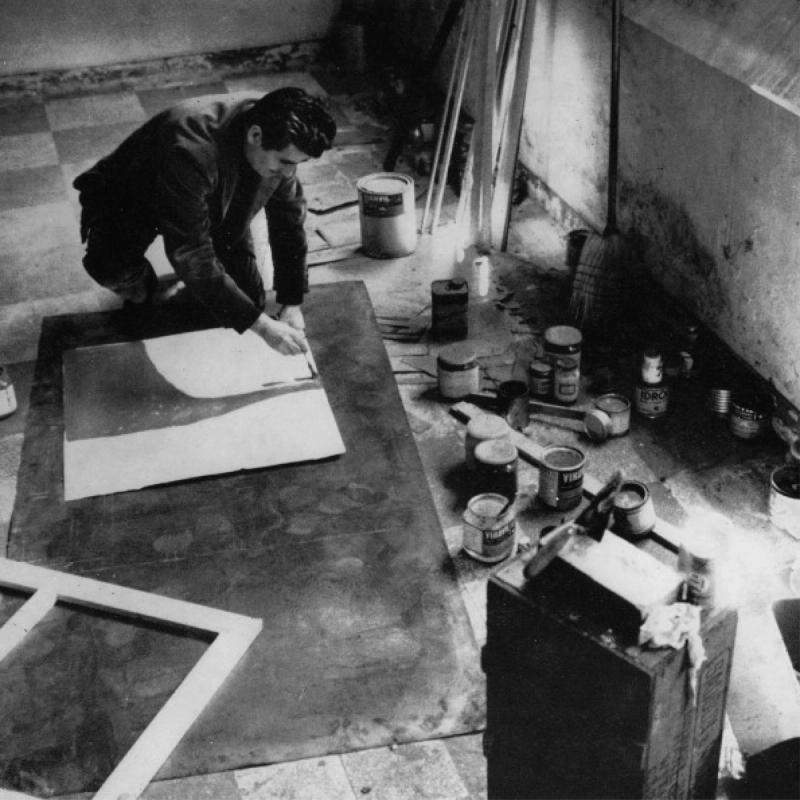Alberto Burri
"My painting is a reality which is part of myself, a reality that I cannot reveal in words."
Italian artist Alberto Burri (1915–1995) transformed the trajectory of postwar painting, rejecting gestural abstraction and symbolism in favor of a new material realism. Subverting traditional processes and materials—he subjected burlap, plastic, and wood to slashing, burning, and stitching—he reconceived the bounds of painting and sculpture to break the illusion of the pictorial field. Though his surfaces often evoke scars, broken skin or earth, and destruction, Burri rejected the idea that the Second World War inspired his work. He rather emphasized the non-neutrality of the materials of painting, acknowledging the ways in which such materials are the product of, and thus reflect, economic and social conditions. Burri’s oeuvre represents a key precedent for such art movements as Arte Povera, Neo-Dada, and Process Art.
Born in Città di Castello, Italy, Burri trained as a surgeon at the Università degli Studi di Perugia (1940) before serving as a frontline soldier and medic in the Second World War. In 1943, Allied troops captured him in Tunisia, and Burri was sent to a prisoner-of-war camp in Texas. There, he began to paint, often on burlap gunny sacks. When he was repatriated to Italy in 1946, he established a studio in Rome. His first solo exhibition was presented at the Galleria La Margherita in 1947. Inspired by the collages of Joan Miró and the heavily worked paintings of Jean Dubuffet, he experimented with unorthodox pigments, resins, pumice, tar, burlap bags, and household fabric. By 1952, he had initiated his series Catrami (Tars), Muffe (Molds), Sacchi (Sacks), and Bianchi (Whites), which earned international acclaim. In 1953, Allan Frumkin Gallery, Chicago, and the Stable Gallery, New York, held his first solo exhibitions in the United States, and his work appeared in Younger European Painters: A Selection at the Solomon R. Guggenheim Museum, New York. The Carnegie Museum of Art, Pittsburgh, organized a midcareer retrospective in 1957. Around that time, in response to Italy’s postwar recovery and rapidly expanding industrial sector, Burri embraced mass-produced materials, including sheet metal, wood veneer, and plastic, which he “painted” with combustion. He torched these materials to melt, char, and eradicate the surface. In the early 1970s he initiated his Cretti (Cracks), monochromatic fields of craquelure. His Grande cretto (1985–89), a 22-acre memorial to the Sicilian town of Gibellina, which was destroyed by an earthquake in 1968, is one of the largest realized Land art works. In 1978, Burri established a foundation, which in 1981 opened a museum dedicated to his work in Città di Castello’s Palazzo Albizzini. From 1963 through 1991, he spent every winter working in Los Angeles. Burri participated in numerous iterations of the Venice Biennale (1952, 1960, 1966, 1984, 1988); and among the many retrospectives dedicated to his work are those mounted by the Museum of Fine Arts, Houston (1963); Musée National d’Art Moderne, Paris (1972); University of California, Los Angeles (1977); and Solomon R. Guggenheim Museum, New York (1978, 2015).
Exhibitions
- Alberto Burri: Cretti Neri
- Luxembourg & Dayan, New York
May 10 - July 30, 2010
Selected Artworks
- Alberto Burri
- Nero cretto, 1979
- Acrovinyl on Celotex
- 19½ × 27⅜ inches (49.5 × 69.5 cm)
- Alberto Burri
- Cretto bianco, 1958
- Acrovinyl on Celotex
- 15³⁄₁₆ × 20½ inches (38.5 × 52 cm)
- Alberto Burri
- Sacco, 1956
- Oil and Vinavil on burlap and canvas
- 27½ × 15¾ inches (69.8 × 40 cm)
